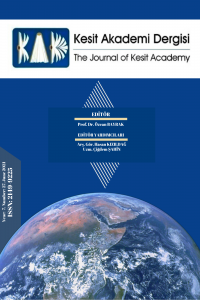Abstract
Tiyatro oyunu çevirmeni, oyundaki dilin hem okunmak hem de oynanmak için kullanıldığının bilincinde olmalı ve okur ile seyircinin de bunu fark etmesini sağlamalıdır. Bu nedenledir ki çevirmen, başka bir dile çevirdiği her satırın, metnin hem sahneye koyulmasında hem de yazılı şekilde, oluşmasını hedeflediği dramatik etkiyi oluşturabilmesi gerektiğinin bilincinde olarak hareket etmelidir. Bu ça-lışmanın amacı, William Shakespeare’in Macbeth isimli eserinin Türkçe çevirisini metinlerarası bağlamda incelemektir. Metnin anlamının oluşmasında önemli işlev-lere sahip olan birtakım metinlerarası yöntemler ele alınırken, kaynak ve hedef me-tinler tahlil edilmiş ve çevirmenin, çeviri eserinde bu metinlerarası öğeleri nasıl kullandığı üzerinde durulmuştur. Özellikle, anıştırma ve gönderme gibi teknikler bu çalışmanın temelini oluşturmakla birlikte, bunların çeviri eserde ne şekilde yan-sıtıldığını incelemek de yine bu çözümlemenin zemininde yer almaktadır. Çeviri metni ve kaynak metni incelerken; çevirmenin, kaynak metin yazarının eserini ya-zarken yararlandığı ya da göndermede bulunduğu metinler ve yazarlar hakkında iyi bir bilgi sahibi olması gerekliliği, belki de en fazla önem teşkil eden husustur. Bunun için, çevirmenin bu farkındalığı ve bilgiyi çeviri eserde nasıl kullandığını saptamak da bu çalışmanın amaçlarından biri olarak görülebilir.
Keywords
References
- Aksoy, N. B. (2002). Geçmişten Günümüze Yazın Çevirisi. İstanbul: İmge.
- Aktulum, K. (2014). Metinlerarası İlişkiler. İstanbul: Öteki Yayınları.
- Allen, G. (2000). Intertextuality. London: Routledge.
- Eco, U. (2021). Gülün Adı. (Çev.: Ş. Karadeniz.). İstanbul: Can Yayınları.
- Evans, B. Ifor. (1943). A Short History of English Literature. London: Penguin Books.
- Greenblatt, S. (Ed.). (2006). The Norton Anthology of English Literature. (8th edition, Volume I). New York: W.W. Norton & Company.
- Lefevere, A. (1992). Translating Literature: Practice and Theory in a Comparative Literature Context. The Modern Language Association of America.
- Schoeck, R.J. (1988). Intertextuality and the Rhetoric Canon. Criticism, History and Intertextuality. (R. Fleming and M. Payne, Ed.). Pennsylvania: Bucknell University Press.
- Shakespeare, W. (1843). Macbeth. Whittaker.
- Shakespeare, W. (2011). Macbeth. (Çev.: Ü.Yapar). Antik Dünya Klasikleri.
- Tahir Gürçağlar, Ş. (2014). Çevirinin ABC’si. İstanbul: Say Yayınları.
- Venuti, L. (2013). Translation, Intertextuality, Interpretation, Romance Studies. 27(3), 157-173.
- https://doi.org/10.1179/174581509X455169
- Wright, C. (2016). Literary Translation. London: Routledge.
Abstract
A translator of drama should be conscient of the fact that the language used in the dramatic work is aimed for both reading and performing, and they should get the reader and the audience distinguish it. For that reason, a translator of drama should take notice that every line they translate to another language carries the dramatic effect that the text sets out in both performance and written form. The aim of this study is to evaluate the Turkish translation of William Shakespeare’s Macbeth in an intertextual context. While taking into consideration some intertextual techniques that have important functions in forming the meaning of the text, the original and the target texts are analyzed and how the translator uses these elements of intertextuality in her translated work are touched upon. In particular, the techniques such as allusion or reference are the ones that form the basis of this study, and how they are reflected in the translated work underlies the ground for this reading. While examining the translated text and the original text; the fact that the translator possesses a good knowledge of the texts and authors the writer of the original text refers to or benefit from while writing their text, carries utmost importance. For that reason, how the translator uses this awareness and knowledge in the translated text, is also analyzed as one of the goals of this study.
References
- Aksoy, N. B. (2002). Geçmişten Günümüze Yazın Çevirisi. İstanbul: İmge.
- Aktulum, K. (2014). Metinlerarası İlişkiler. İstanbul: Öteki Yayınları.
- Allen, G. (2000). Intertextuality. London: Routledge.
- Eco, U. (2021). Gülün Adı. (Çev.: Ş. Karadeniz.). İstanbul: Can Yayınları.
- Evans, B. Ifor. (1943). A Short History of English Literature. London: Penguin Books.
- Greenblatt, S. (Ed.). (2006). The Norton Anthology of English Literature. (8th edition, Volume I). New York: W.W. Norton & Company.
- Lefevere, A. (1992). Translating Literature: Practice and Theory in a Comparative Literature Context. The Modern Language Association of America.
- Schoeck, R.J. (1988). Intertextuality and the Rhetoric Canon. Criticism, History and Intertextuality. (R. Fleming and M. Payne, Ed.). Pennsylvania: Bucknell University Press.
- Shakespeare, W. (1843). Macbeth. Whittaker.
- Shakespeare, W. (2011). Macbeth. (Çev.: Ü.Yapar). Antik Dünya Klasikleri.
- Tahir Gürçağlar, Ş. (2014). Çevirinin ABC’si. İstanbul: Say Yayınları.
- Venuti, L. (2013). Translation, Intertextuality, Interpretation, Romance Studies. 27(3), 157-173.
- https://doi.org/10.1179/174581509X455169
- Wright, C. (2016). Literary Translation. London: Routledge.
Details
| Primary Language | English |
|---|---|
| Journal Section | Research Articles |
| Authors | |
| Publication Date | June 25, 2021 |
| Published in Issue | Year 2021 Volume: 7 Issue: 27 |


